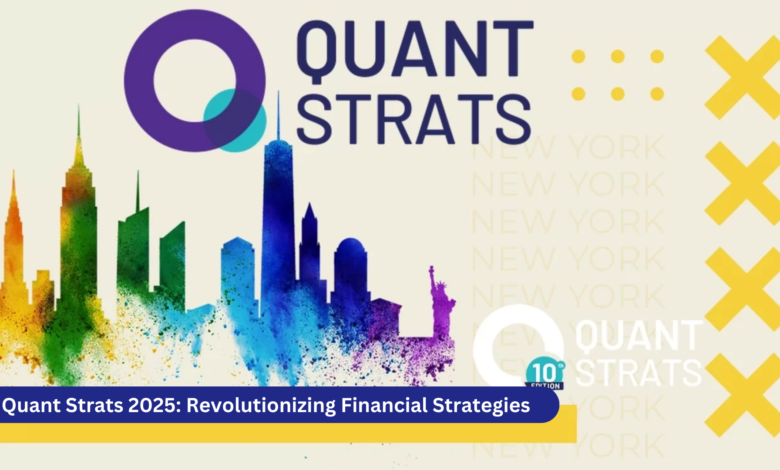Quant Strats 2025: Revolutionizing Financial Strategies

Introduction
Quantitative strategies, or “quant strats,” are the backbone of modern trading and investment. They leverage advanced mathematical models, data analysis, and cutting-edge technology to make smarter, faster, and more accurate decisions in financial markets. As we approach 2025, the financial landscape is set for a transformation driven by artificial intelligence (AI), quantum computing, and big data.
This blog is your go-to guide for understanding quant strats in 2025. Whether you’re an investor, a financial analyst, or just curious about how finance is evolving, this article will equip you with everything you need to know.
What Are Quant Strats?
Quantitative strategies are systematic approaches to trading and investing that rely on numbers, algorithms, and logic rather than intuition or emotion. These strategies aim to identify patterns and trends in the market, which can be used to predict future price movements, optimize portfolios, or reduce risks.
Examples of popular quantitative strategies include:
- Momentum Trading: Identifying stocks or assets that are likely to continue rising or falling.
- Statistical Arbitrage: Exploiting short-term pricing inefficiencies between correlated assets.
- Algorithmic Execution: Automating trade execution to minimize costs and maximize speed.
In 2025, these strategies are expected to become even more advanced, incorporating cutting-edge tools like artificial intelligence and quantum computing.
Why Are Quant Strats So Popular?
Quantitative strategies are increasingly popular because they:
- Eliminate Human Error: Removing emotional decisions from trading reduces mistakes.
- Maximize Efficiency: Quant models can process millions of data points in real-time.
- Provide Consistency: Algorithms stick to rules, ensuring consistent performance.
- Handle Complexity: Modern markets are vast and complex; quant strats simplify decision-making.
By 2025, their popularity is likely to skyrocket as technological advancements make them even more powerful.
Key Trends Shaping Quant Strats in 2025
1. AI-Powered Innovations
AI and machine learning are leading the charge in revolutionizing quant strategies. Here’s how:
- Advanced Forecasting Models: AI now predicts market trends with higher accuracy than ever before.
- Sentiment Analysis: Using natural language processing (NLP) to gauge public opinion from news, tweets, and social media.
- Self-Learning Algorithms: AI systems that improve themselves by learning from past performance.
2. Real-Time Big Data
Data is the new oil in finance. In 2025, traders and analysts are tapping into:
- Alternative Data Sources: Weather patterns, satellite imagery, and even foot traffic in malls can now influence trading decisions.
- Live Streaming Data: Real-time feeds help detect and react to market changes instantly.
- Deeper Analytics: With advanced tools, even unstructured data (like text and images) is being analyzed for financial insights.
3. Quantum Computing
The introduction of quantum computing in finance is a game-changer. In 2025, it’s helping quants:
- Solve complex optimization problems in seconds.
- Execute thousands of trades simultaneously with unparalleled precision.
- Explore new possibilities in portfolio management and risk reduction.
4. Blockchain and DeFi Integration
Decentralized finance (DeFi) is merging with traditional quant strategies. Key developments include:
- Smart Contracts: Automating transactions securely and transparently.
- Crypto Arbitrage: Exploiting price differences across crypto exchanges.
- Tokenized Assets: Expanding investment opportunities into digital assets.
5. ESG Investments
Environmental, Social, and Governance (ESG) factors are becoming integral. Quant strats are evolving to measure and incorporate ESG metrics, ensuring sustainability and ethical considerations in investment decisions.
How to Create a Quant Strat in 2025
If you’re interested in building your own quant strat, follow these steps:
1. Define Your Goal
Decide what you want to achieve—higher returns, lower risk, or specific market exposure.
2. Gather High-Quality Data
Use reliable data sources like Bloomberg, Quandl, or alternative data providers. Data accuracy is crucial.
3. Develop Your Model
Choose the right tools, such as Python, R, or MATLAB. Use AI and machine learning libraries like TensorFlow or PyTorch.
4. Backtest Your Strategy
Test your model against historical data to see how it would have performed.
5. Optimize and Refine
Adjust parameters, clean your data, and repeat the testing process to maximize performance.
6. Monitor Performance
Even after deployment, monitor your strategy to ensure it adapts to changing market conditions.
Real-World Applications of Quant Strats in 2025
1. Hedge Funds
Leading hedge funds like Renaissance Technologies and Citadel rely heavily on quant strategies to deliver consistent returns.
2. Retail Investors
Platforms like QuantConnect and Alpaca are making quant strategies accessible to individual traders.
3. Risk Management
Banks and financial institutions use quant models to predict and mitigate risks, ensuring stability.
4. Portfolio Optimization
Advisors and robo-advisors utilize quant techniques to create diversified, high-performing portfolios.
Advantages and Limitations of Quant Strats
Advantages
- Speed and Efficiency: Automate repetitive tasks.
- Data-Driven Decisions: Remove bias and emotion.
- High Scalability: Manage complex portfolios effortlessly.
- Cost Reduction: Minimize human intervention.
Limitations
- Overfitting: Models that perform well in backtesting may fail in real markets.
- Data Quality Issues: Inaccurate or incomplete data can skew results.
- Technological Risks: Bugs or cyberattacks could disrupt operations.
The Future of Quant Strats Beyond 2025
As technology advances, the scope of quantitative strategies will expand. Key areas of growth include:
- Global Market Integration: Seamless trading across borders and time zones.
- Personalized Finance: Tailored strategies for individual investors.
- Collaborative AI Systems: Teams of AI systems working together to enhance decision-making.
Conclusion
Quantitative strategies are the future of finance, blending the power of technology with market expertise. As we step into 2025, innovations in AI, big data, quantum computing, and blockchain will redefine what’s possible. Whether you’re a seasoned trader or just starting, embracing these trends will help you stay ahead in the competitive financial world.
The time to explore and implement quant strategies is now—don’t get left behind in this data-driven revolution.
FAQs About Quant Strats 2025
Q1. What are quant strats?
Quantitative strategies use mathematical models and algorithms to analyze data and make trading decisions.
Q2. How is AI used in quant strategies?
AI enhances predictions, analyzes alternative data, and adapts strategies to market changes in real-time.
Q3. What is the role of big data in quant strategies?
Big data helps identify trends, analyze patterns, and make more informed trading decisions.
Q4. Can beginners use quant strategies?
Yes, many platforms provide user-friendly tools for beginners to experiment with quant strategies.
Q5. Is quantum computing widely used in finance?
While still emerging, quantum computing is gaining traction for solving complex problems quickly.
Q6. How do quant strategies handle risks?
They use statistical models and simulations to predict potential losses and mitigate risks effectively.
Q7. What tools are needed to build a quant strat?
Popular tools include Python, R, MATLAB, and AI libraries like TensorFlow.
Q8. Are quant strats applicable to cryptocurrencies?
Yes, many quant strategies are tailored for cryptocurrency markets, especially in areas like arbitrage and sentiment analysis.
By understanding these insights and trends, you’ll be better equipped to navigate the future of finance and make smarter investment decisions.


